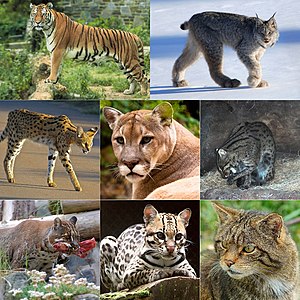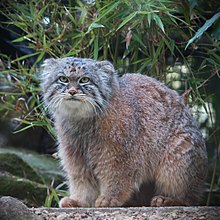The Cats PortalFelidae ( /ˈfɛlɪdiː/) is the family of mammals in the order Carnivora colloquially referred to as cats. A member of this family is also called a felid ( /ˈfiːlɪd/). The term "cat" refers both to felids in general and specifically to the domestic cat ( Felis catus). The 41 extant Felidae species exhibit the greatest diversity in fur patterns of all terrestrial carnivores. Cats have retractile claws, slender muscular bodies and strong flexible forelimbs. Their teeth and facial muscles allow for a powerful bite. They are all obligate carnivores, and most are solitary predators ambushing or stalking their prey. Wild cats occur in Africa, Europe, Asia and the Americas. Some wild cat species are adapted to forest and savanna habitats, some to arid environments, and a few also to wetlands and mountainous terrain. Their activity patterns range from nocturnal and crepuscular to diurnal, depending on their preferred prey species. ( Full article...) Selected species -The Pallas's cat (Otocolobus manul), also known as the manul, is a small wild cat with long and dense light grey fur, and rounded ears set low on the sides of the head. Its head-and-body length ranges from 46 to 65 cm (18 to 26 in) with a 21 to 31 cm (8.3 to 12.2 in) long bushy tail. It is well camouflaged and adapted to the cold continental climate in its native range, which receives little rainfall and experiences a wide range of temperatures. The Pallas's cat was first described in 1776 by Peter Simon Pallas, who observed it in the vicinity of Lake Baikal. Since then, it has been recorded across a large region in Central Asia, albeit in widely spaced sites from the Caucasus, Iranian Plateau, Hindu Kush, parts of the Himalayas, Tibetan Plateau to the Altai-Sayan region and South Siberian Mountains. It inhabits rocky montane grasslands and shrublands, where the snow cover is below 15–20 cm (6–8 in). It finds shelter in rock crevices and burrows, and preys foremost on lagomorphs and rodents. The female gives birth to between two and six kittens in spring. ( Full article...) List articles
Related portalsWikiProjectsSelected breed -The Persian cat, also known as the Persian Longhair, is a long-haired breed of cat characterised by a round face and short muzzle. The first documented ancestors of Persian cats might have been imported into Italy from Khorasan as early as around 1620, however, this has not been proven. Instead, there is stronger evidence for a longhaired cat breed being exported from Afghanistan and Iran from the 19th century onwards. Widely recognised by the North-West European cat fancy since the 19th century, and after World War II by breeders from North America, Australia and New Zealand. Some cat fancier organisations' breed standards subsume the Himalayan and Exotic Shorthair as variants of this breed, while others generally treat them as separate breeds. The selective breeding carried out by breeders has allowed the development of a wide variety of coat colours, but has also led to the creation of increasingly flat-faced Persian cats. Favoured by fanciers, this head structure can bring with it several health problems. As is the case with the Siamese breed, there have been efforts by some breeders to preserve the older type of cat, the Traditional Persian, which has a more pronounced muzzle. Hereditary polycystic kidney disease (PKD) is prevalent in the breed, affecting almost half of the population in some countries. ( Full article...) Did you know... -
TopicsAssociated WikimediaThe following Wikimedia Foundation sister projects provide more on this subject:
Discover Wikipedia using
portals |
























